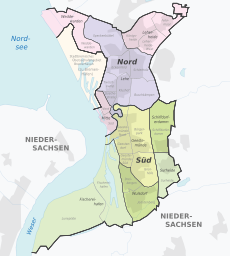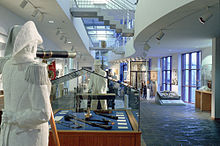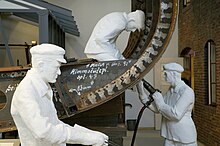Historical Museum Bremerhaven
 entrance |
|
| Data | |
|---|---|
| place | Bremerhaven |
| Art |
Historical museum, regional museum
|
| architect | Wolfgang Bendig |
| opening | 1991 |
| operator |
City of Bremerhaven
|
| management |
Kai Kähler
|
| Website | |
| ISIL | DE-MUS-028211 |
Location in Bremerhaven |
The Historical Museum Bremerhaven - formerly the Morgenstern Museum - is located on the banks of the Geeste and shows the history of Bremerhaven and its surroundings.
history
Since the end of the 19th century, the men from Morgenstern (Heimatbund at the mouth of the Elbe and Weser) have been putting together a collection that mainly consisted of archaeological and folklore objects. In 1896 Jan Bohls arranged the prehistoric collection in Lehe (Bremerhaven) in a house at Hafenstrasse 6 and exhibited it to the public. He was the first curator of the collection.
Geestemünde
In 1902 the collection was sold to Geestemünde and the Museum für Heimatkunde was founded, which opened on January 15, 1906 in the rooms of the Geestemünde Higher Girls' School. In addition to the prehistoric and early historical holdings, larger folklore collections with ceramics, pewter, furniture and costume jewelry were added, which made it necessary to expand the museum space.
In 1909 the museum moved to ten rooms on the upper floor of the Geestemünde Chamber of Commerce . In 1910 the reopening as the Städtisches Morgenstern Museum was celebrated. At that time the teacher Friedrich Plettke was honorary museum director. He was supported by members of the Men from Morning Star Association, so that the new museum name quickly caught on in the population. In 1926 the museum acquired further folkloric and archaeological holdings from the collector Hans Müller-Brauel . In the 1930s, the museum gained a national reputation. The director of the Provincial Museum in Hanover, Karl Jacob-Friesen, wrote in 1939: "When it comes to local museums, Wesermünde is one of the leading cities ..." . In 1942 the museum's collection was relocated due to the war and reorganized in the Marschenhaus in the Speckenbüttel district in 1945/46 . The museum building was destroyed in the air raids on Wesermünde in 1944. A fire in the Marsh House in 1946 destroyed important holdings.
Townhouse
Since 1949, on the initiative of the new honorary museum director Johann Jacob Cordes , the remaining holdings have been made accessible to the public again, initially in temporary rooms in Bremerhaven's Stadthaus IV. The collection continued to consist mainly of folklore and prehistoric exhibits. Since 1950, thanks to the efforts of JJ Cordes, three private donors have added individual exhibits from the fields of seafaring, shipbuilding, port management and fishing, which were first shown in a special exhibition in 1951. With further additions, a shipping department was set up in the following years. In addition, a contract from 1950 between the Wesermünde district and Bremerhaven secured the museum's new discoveries from the preservation of historical monuments, including finds from the village of Feddersen Wierde .
After JJ Cordes, the museum was run on a voluntary basis by the director of studies Theodor A. Schröter and former museum director. D. Hans Gummel directed. From 1959 to 1989 there was a full-time museum director for the first time, folklorist Gert Schlechtriem .
Kaistraße
On February 6, 1961, the museum opened new exhibition rooms at Kaistraße 5–6 at the marina in a former department store. The museum was now divided into three areas: a prehistoric department, a maritime history department and a folklore department. In the 1960s, Schlechtriem systematically expanded the shipping history collection.
The important collection on shipping history was handed over to the newly founded German Maritime Museum in Bremerhaven in 1973 by decision of the municipal authorities . After years of conceptual standstill, the citizens of Bremerhaven founded the sponsorship group Morgenstern-Museum der Seestadt Bremerhaven e. V. This support contributed significantly to the fact that the city council decided to build a new building for the city museum in the early 1980s. Associated with this was a new content concept with the city and regional history as the focus. This resulted in a name change in the Historical Museum for Bremerhaven and the surrounding area / Morgenstern Museum . In 2004 the name of the museum was changed to the Historisches Museum Bremerhaven by resolution of the city council .
The Historisches Museum Bremerhaven has been a stop on the Route of Industrial Culture in the northwest since 2010 .
Today's museum
On September 1, 1989, the historian Alfred Kube took over the full-time management of the museum. He developed a new concept in terms of content and design for the new museum building, which the city council approved in 1990. The new 4760 m 2 building on the banks of the Geeste, based on a design by the Bremerhaven architect Wolfgang Bendig, was opened on August 31, 1991. With its five pointed gables, the building quotes the former fish halls that stood at this point. The curved shape of the 100 m long museum building is based on the Geestebogen. The interior design is bright and transparent in a gallery construction. The museum building and the design of the permanent exhibition received several awards. In 2000, the Historical Museum Bremerhaven was nominated for European Museum of the Year.
The permanent exhibition conceived and designed by Kube and folklorist Anja Benscheidt was completed from 1991 onwards. For the most part, new collections first had to be put together for the departments.
The permanent exhibition shows the history of Bremerhaven and the surrounding area from the first traces of human settlement 120,000 years ago to the 1960s in seven sections:
- Bremerhaven and the surrounding area 1827–1927
- Bremerhaven and the surrounding area 1920–1960
- Deep sea fishing and fishing industry
- Overseas ports and port work
- Shipyards and shipbuilding
- Treasures from the Elbe-Weser triangle
- Picture gallery
In addition to the permanent exhibition, the Historical Museum Bremerhaven regularly presents special exhibitions on various topics. A diverse range of events with public tours, lectures and concerts is aimed at the general public. The Historisches Museum Bremerhaven offers a range of educational museum programs on various topics, especially for children. In December 2019, Kube retired. Anja Benscheidt, who worked closely with Kube, took over the management of the museum. Kai Kähler, the chairman of the Bremerhaven Art Association, has been director of the museum since the beginning of August 2020, after Anja Benscheidt also retired.
Museum ship FMS Gera
The museum ship Gera is operated by the Historisches Museum Bremerhaven as a branch in the Schaufenster Fischereihafen and the only German floating museum on the history of deep-sea fishing. In 1990, the last German side catcher was saved from being scrapped. The city of Bremerhaven bought the ship for the symbolic price of DM 1 and handed it over to the Bremerhaven Historical Museum.
The Gera was built in 1959/60 at the Peenewerft in Wolgast and was in the service of the Rostock fish combine until 1990 . The Gera is 65.55 m long and measured at 942.89 GRT. It is designed as a side trawler, i. H. the net was deployed on the starboard side. A fishing net winch, gallows and loading booms supported the launching and hauling in of the net. Still, most of the work had to be done by human power.
Time stood still on the last German side catcher. Here, visitors can see the original equipment, from the safety net to the machinery and the chambers. An exhibition, large photos and documentaries illustrate the hard everyday work on board.
The Freundeskreis Gera offers a demonstration program on special occasions . A captain stands on the bridge and explains the nautical equipment, a best man demonstrates the work on the fishing deck and the machine team puts the father and son system into operation. Groups can book tours with a former deep-sea fisherman. A museum educational program is offered for school classes and children's birthdays after registration.
German emigrant database
For a long time Bremerhaven was the largest European emigration port. Between 1830 and 1974, over 7 million people left Europe via the Seestadt to start a new life overseas. The Historical Museum Bremerhaven initiated the German Emigrant Database as a decentralized EXPO project 2000. Scientific cooperation partners are the University of Bremerhaven and Castle Garden Immigration Research, New York, USA. The sponsor group Historisches Museum Bremerhaven e. V.
The aim is to collect comprehensive information on people who left Europe between 1820 and 1939, primarily via German ports. The basis for this is provided by the passenger lists that each ship had to present on arrival in North America. The early lists from the middle of the 19th century contained 14 items of information about each person; at the beginning of the 20th century, 40 items of information were recorded for each emigrant. In the lists u. a. Name, gender, age, occupation, port of departure, last place of residence and information about the ship, later also skin, hair and eye color, as well as information about the state of health and possible prison stays. The original passenger lists are largely preserved in the National Archives in New York from 1820 onwards. Further sources supplement the information. In addition, the research project evaluates the data obtained for social statistics.
The German Emigrant Database currently (as of 2013) contains around 5 million recorded emigrants, mainly from the years 1820–1897, 1904 and 1907.
Visitors to the Historisches Museum Bremerhaven can search the database for emigrated passengers free of charge at two terminals in the exhibition rooms. Since December 2007 it has also been possible to search for emigrants independently via the Internet. The support group Historisches Museum Bremerhaven e. V. also offers a research service that enables a comprehensive search.
Art Nouveau window
The HMB houses an Art Nouveau window that was made around 1906. It was located in the stairwell of Bürgermeister-Smidt-Straße 188 until 1991 and was listed there in 1978. It is listed as a movable monument in the state of Bremen's list of monuments.
Sponsorship group
The support group Historisches Museum Bremerhaven e. V. supports the work of the Historisches Museum Bremerhaven ideally and materially. Central tasks are the financing of the purchase of exhibits, special exhibitions, research projects and the mediation work of the museum. In addition, the support group finances the cashier and supervisory service on the museum ship FMS “GERA” as well as the operation and expansion of the research project German Emigrant Database .
literature
- Alfred Kube: History in the Museum. The Morgenstern Museum as a historical museum. In: Yearbook of the Men of the Morning Star. No. 69 (1990), pp. 229-232.
- Anja Benscheidt, Alfred Kube: Morgenstern Museum. Concept, exhibition, architecture . (Small writings of the Morgenstern Museum, Volume 1), Bremerhaven 1992.
- Anja Benscheidt, Alfred Kube: Bremerhaven and the surrounding area 1827–1927 (History in the Morgenstern Museum, Volume 1. Ed .: Förderkreis Morgenstern Museum der Seestadt Bremerhaven eV), Bremerhaven 1993, ISBN 3-927857-47-5 .
- Anja Benscheidt, Alfred Kube: The last German side trawler. Deep sea fishing history on the museum ship “GERA” . (Small writings of the Historisches Museum Bremerhaven, Volume 3), Bremerhaven 1995, ISBN 3-931285-00-6 .
- Alfred Kube: fishing motor ship ROS 223 “Gera”. The last side trawler as a museum ship. In: Maritime monument protection in Europe - in the conflict between private initiatives and public interests. Bremerhaven 1995, pp. 32-48.
- Anja Benscheidt, Alfred Kube: Historical Museum Bremerhaven / Morgenstern Museum. The slightly different museum . (Small writings of the Historisches Museum Bremerhaven, Volume 4), Bremerhaven 1999, ISBN 3-89701-323-1 .
- Anja Benscheidt, Alfred Kube: Historical Museum Bremerhaven / Morgenstern Museum. The museum with a difference . (Small writings of the Historisches Museum Bremerhaven, Volume 5), Bremerhaven 1999, ISBN 3-89701-324-X .
- Anja Benscheidt, Alfred Kube: What takes a long time ... The completion of the Historical Museum Bremerhaven / Morgenstern Museum . In: Bulletin of the Museum Association for Lower Saxony and Bremen e. V. No. 58 (1999), pp. 27-36.
- Anja Benscheidt, Alfred Kube (Hrsg.): The German emigrant database. Passenger lists as research sources . (Small writings of the Historisches Museum Bremerhaven, Volume 7), Bremerhaven 2006, ISBN 3-931285-01-4 .
- Herbert Körtke: On the history of the Morgenstern Museum in Bremerhaven. In: Yearbook of the Men of the Morning Star. No. 85 (2006), pp. 251-303.
- Anja Benscheidt, Alfred Kube: Bremerhaven & Geestemünde. Historical views of two competing port cities. (History in Pictures, Volume 5), Bremerhaven 2010, ISBN 978-3-86918-045-8 .
- Alfred Kube: 110 years of the municipal museum in the Lower Weser towns. In 1906 the "Städtische Morgenstern-Museum" opened in Geestemünde . In: Men from Morgenstern, Heimatbund an Elbe and Weser estuary e. V. (Ed.): Niederdeutsches Heimatblatt . No. 793 . Nordsee-Zeitung GmbH, Bremerhaven January 2016, p. 1–2 ( digitized version [PDF; 1.5 MB ; accessed on September 9, 2019]).
Web links
- Literature from and about the Historisches Museum Bremerhaven in the catalog of the German National Library
- official homepage
- German emigrant database
Individual evidence
- ↑ Metropolitan Region Bremen-Oldenburg in the Northwest e. V .: Route of industrial culture in the northwest. Station 12: Historical Museum Bremerhaven. ( Page no longer available , search in web archives ) Info: The link was automatically marked as defective. Please check the link according to the instructions and then remove this notice.
- ↑ Nordwestzeitung online from December 6, 2019: Historical Museum. Retired without farewell, by Heiner Otto , accessed on December 6, 2019
- ↑ Sebastian Loskant: Kai Kähler is the new head of the Historical Museum. In: Nord24. June 21, 2020, accessed August 16, 2020 .
- ^ Monument database of the LfD
Coordinates: 53 ° 32 ′ 19.7 " N , 8 ° 35 ′ 8.3" E





